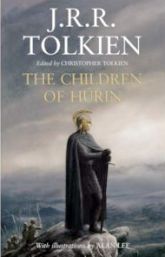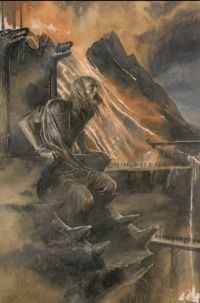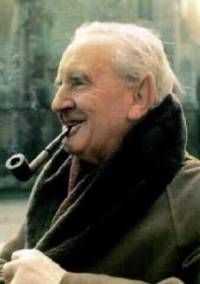“A darkness lies behind us, and out of it few tales have come,” says one character early in J.R.R. Tolkien’s The Children of Húrin. “…It may be that we fled from the fear of the Dark, only to find it here before us, and nowhere else to fly to but the Sea.”
 Sador is speaking here about the race of Men, and his statement may sum up Tolkien’s recently published novel as good as any. Children of Húrin is a tale about fear and Man’s futile attempts to wrest honor and courage from the jaws of certain doom. It’s a major new work, though incomplete, and one of the clearest distillations of Tolkien’s thought since the publication of The Silmarillion in the late ’70s.
Sador is speaking here about the race of Men, and his statement may sum up Tolkien’s recently published novel as good as any. Children of Húrin is a tale about fear and Man’s futile attempts to wrest honor and courage from the jaws of certain doom. It’s a major new work, though incomplete, and one of the clearest distillations of Tolkien’s thought since the publication of The Silmarillion in the late ’70s.
Those who have already read The Silmarillion will find a lot that’s familiar here. (For those who haven’t, be warned that there will be spoilers here.) The Children of Húrin is just an expanded version of the tale of Túrin Turambar, the longest (and best) chapter from that book. Having just recently read The Silmarillion myself, honestly this tale doesn’t seem all that different from the previously published version; fragments of the story also appeared in Unfinished Tales.
Technically, The Children of Húrin can be read as a stand-alone tale. It has a beginning and an ending, for the most part. But I imagine that readers who had trouble getting through The Silmarillion will have a difficult time understanding the context of what’s happening here. Who is this Morgoth, exactly? What’s all this about Fëanor and his sons? Christopher Tolkien does a rather poor job in the Introduction at summarizing the larger context of the story. We’re left with passages like this:
The second son of Finwë was Fingolfin (the half brother of Fëanor), who was held the overlord of all the Noldor; and he with his son Fingon ruled Hithlum, which lay to the north and west of the great chain of Ered Wethrin, the Mountains of Shadow. Fingolfin dwelt in Mithrim, by the great lake of that name, while Fingon held Dor-lómin in the south of Hithlum. Their chief fortress was Barad Eithel (the Tower of the Well)….
Or, more concisely stated, Yawwwwwwwwwwn.
So here’s basically what you need to know. Once upon a time the Valar (the gods) invited the immortal Elves to the land of Valinor in the West. There Fëanor, the smartest Elf in the pack, made three one-of-a-kind jewels called the Silmarils. But the evil god Morgoth stole them and took off to the land of Beleriand. Fëanor and many of his people went after him, rebelling against the Valar and taking an oath never to rest until the Silmarils had been recovered. The Elves established a bunch of kingdoms in Beleriand and have been fighting Morgoth for a few hundred years now (with the help of the Edain, the good Men).
But the tale of the Elves is really not as crucial in The Children of Húrin as that of Men. The main character of the book, Túrin son of Húrin, is a Man, after all. And the book revolves around this character’s noble, yet futile, attempts to rise to greatness.
It’s said in The Silmarillion that Elves are bound to the Earth. The Elves are immortal, and even when they die their souls sit in the halls of Mandos (a Hades of sorts) until they’re eventually resurrected. But Men have been granted the gift of death by Eru the One, their Creator. This means that Men’s souls leave the circles of the world when they die and go someplace that nobody, not even the Valar, know where.
 Fine. Except when Men first wake up after their creation, it’s Morgoth they stumble into first. Without the Valar around, Morgoth pretends to befriend the first Men and turns death — originally intended as a gift from Eru — into something to dread and fear.
Fine. Except when Men first wake up after their creation, it’s Morgoth they stumble into first. Without the Valar around, Morgoth pretends to befriend the first Men and turns death — originally intended as a gift from Eru — into something to dread and fear.
Fear, as I mentioned before, is the predominant theme of Children of Húrin. And it seems to be the primary Achilles’ heel of Men in Tolkien’s world, one we see arise again and again throughout the book. Dorlas shrinks from facing the dragon Glaurung from fear; Brodda the Easterling conquers Dor-lómin but is afraid to harm Húrin’s wife Morwen; Mîm the Dwarf ultimately betrays Túrin’s hideout from fear of the Orcs who have kidnapped his son; and so on.
But the house of Húrin is a race apart. “This land might pass into [Morgoth’s] dominion,” Húrin tells his wife. “But if things do go ill, I will not say to you: Do not be afraid! For you fear what should be feared, and that only; and fear does not dismay you.”
The faithful household retainer Sador tells Túrin that “a man that flies from his fear may find that he has only taken a short cut to meet it.” And so Túrin takes up arms against his foes even though others counsel him to hide and preserve his strength. Niënor stands in front of the dragon Glaurung and tells him to his face “The children of Húrin at least are not craven. We fear you not.” Húrin defies the will of Morgoth himself under torture in Angband, and brings down the curse of Morgoth upon him:
But upon all whom you love my thought shall weigh as a cloud of Doom, and it shall bring them down into darkness and despair. Wherever they go, evil shall arise. Whenever they speak, their words shall bring ill counsel. Whatsoever they do shall turn against them. They shall die without hope, cursing both life and death.
Húrin, undaunted, replies:
Such things you spoke long ago to our fathers; but we escaped from your shadow. And now we have knowledge of you, for we have looked on the faces that have seen the Light, and heard the voices that have spoken with [king of the Valar] Manwë. Before Arda you were, but others also; and you did not make it.
If this confrontation sounds familiar, it should. It’s essentially a reworking of the Book of Job in the Old Testament. God allows the Devil to throw calamity after calamity on the hapless Job in an effort to test his faith; here Morgoth puts Húrin on a chair and bids him to watch how his children Túrin and Niënor fare against his onslaught of evil.
 But here’s the interesting thing: Tolkien’s sympathies are with Túrin Turambar, much as they were with Fëanor in The Silmarillion. There’s a nobility in the character that overarches everything he does, even though it leads to ruin in the end.
But here’s the interesting thing: Tolkien’s sympathies are with Túrin Turambar, much as they were with Fëanor in The Silmarillion. There’s a nobility in the character that overarches everything he does, even though it leads to ruin in the end.
It’s very interesting that throughout the history of Middle Earth — in all of Tolkien’s major works — the constant reaction of the Elves and the Valar, the “good guys,” is to run and hide. Confronted with Morgoth’s betrayal and Fëanor’s rebellion, the Valar wall off their sacred realm of Valinor and stay there. Thingol and Melian retreat behind the enchanted Girdle around the forest of Doriath. Turgon and Finrod make themselves scarce inside their secret realms of Gondolin and Nargothrond. And in The Lord of the Rings, three of the remaining Elvish lords — Elrond, Galadriel, and Thranduil — stay entrenched in their protected havens, while the fourth, Círdan, is basically just hanging out in Middle Earth to help hustle anyone who will go back to Valinor.
And the race of Men? Well, we’re the weak ones, the fickle ones, the Lesser Children of Eru. But while the sons of Fëanor bitch and moan about their stolen Silmarils for hundreds of years, it’s the Man Beren who actually dares to go to Angband and do something about it. When Sauron grows strong in Middle Earth during the Second Age, the Elves sit back and let it happen while the men of Númenor go forth and kick some ass. Even in the Third Age, the Men of Rohan and Gondor are the ones who are putting their butts on the line to challenge Sauron. Remember that in Tolkien’s Two Towers, there was no brave cadre of Elvish archers coming to the rescue at Helm’s Deep like in Peter Jackson’s film.
Nobody embodies this boldness and nobility so much as Túrin. Círdan sends a message to Nargothrond telling them, “Shut the doors of the fortress, and go not abroad. Cast the stones of your pride into the loud river, that the creeping evil may not find the gate.” But Túrin refuses to be a hostage to his fate and to huddle in a cave. He calls Círdan’s messenger “a runagate from war,” and says “it will still seem better in our case to muster our strength, and go boldly to meet our foes, ere they come too nigh.” The Elves run from the dragon Glaurung; Túrin insists on going forth to challenge him.
Unfortunately, the greatest attribute of Men is also what leads to their downfall. Remember Gimli saying in The Return of the King that “With its own weapons was [Mordor] worsted”? So it is with Men. If the impulse to rebel against fear and darkness is what inspires us to great deeds, it also leads to the pride that’s our undoing in the end.
Notice all the examples of handicap, decay, and degeneration in The Children of Húrin. There’s Sador Labadal, who accidentally sliced off part of his foot due to his carelessness with an ax (very symbolic, that). There’s Brandir, the clubfooted leader of the men of Brethil. There’s Gwindor, the Elf of Nargothrond who only escapes the dungeons of Angband after losing a hand. And then there’s Mîm, last of a dying breed of Petty-Dwarves devolved from greatness due to their pettiness and greed.
 What happens to Túrin in the end? Túrin can’t rise above his circumstances. He seeks to ennoble the race of Men and restore his house to greatness; instead, time and again his pride blinds him to the better advice of those around him. Pitting himself against Glaurung the dragon is one thing; but to defy Morgoth? Remember that this is the dude that literally invented evil. He was the one who sought to mar Eru’s divine plan during the very act of creation itself.
What happens to Túrin in the end? Túrin can’t rise above his circumstances. He seeks to ennoble the race of Men and restore his house to greatness; instead, time and again his pride blinds him to the better advice of those around him. Pitting himself against Glaurung the dragon is one thing; but to defy Morgoth? Remember that this is the dude that literally invented evil. He was the one who sought to mar Eru’s divine plan during the very act of creation itself.
So Túrin is doomed to slay his friends through many a case of mistaken identity. He leads the great Elvish fortress of Nargothrond to ruin, he unknowingly marries and impregnates his own sister, and he in general hastens the collapse of all Beleriand under the armies of Morgoth.
In the end (as Tolkien tells in The Silmarillion), it’s not force of arms that conquers Morgoth. It’s the selfless mission of mercy to Valinor undertaken by Eärendil that causes the Valar to finally step out from their refuge and call on the help of Eru. Just the same, it’s not Aragorn’s army that ultimately wins the victory over Sauron in The Lord of the Rings; it’s Frodo’s pity in not slaying Gollum (and Bilbo’s, and Sam’s, and everyone else’s).
So are we to admire Túrin or pity him? Is he a character to look up to or a character to revile?
Perhaps, as I noted in my discussion of The Return of the King, one side of Túrin Turambar can’t exist without the other. In The Children of Húrin, it seems to me, Tolkien’s moral determinism strikes again. Túrin’s story isn’t so much a cautionary tale as it is an observation. Tolkien is saying: This is how Men are. This is how Eru created the world. This is the symphony the great Composer in the Sky has composed for us.
***
(One small side note: The book is filled with glossy full-color paintings from Alan Lee, which was an unexpected treat. Most of these paintings are quite phenomenal. But am I wrong to feel gypped that, in a book that spends so much time dealing with a dragon, there isn’t a single clear illustration of a dragon here? I admit dragons are a somewhat predictable topic for cover art on a fantasy novel. But I’m surprised that Houghton Mifflin would publish such a major commercial book with such a subdued and unassuming cover. You think the Tolkien estate twisted HM’s arms?)
***
(Another note: Why would Christopher Tolkien choose to omit the further material about Húrin’s death, which appeared both in The Silmarillion and The War of the Jewels? The fragment that appears in the book’s last pages feels jarringly incomplete. At the very least, I would have liked to see the scene where that little fucker Mîm the Petty-Dwarf gets what’s coming to him. Oh well.)